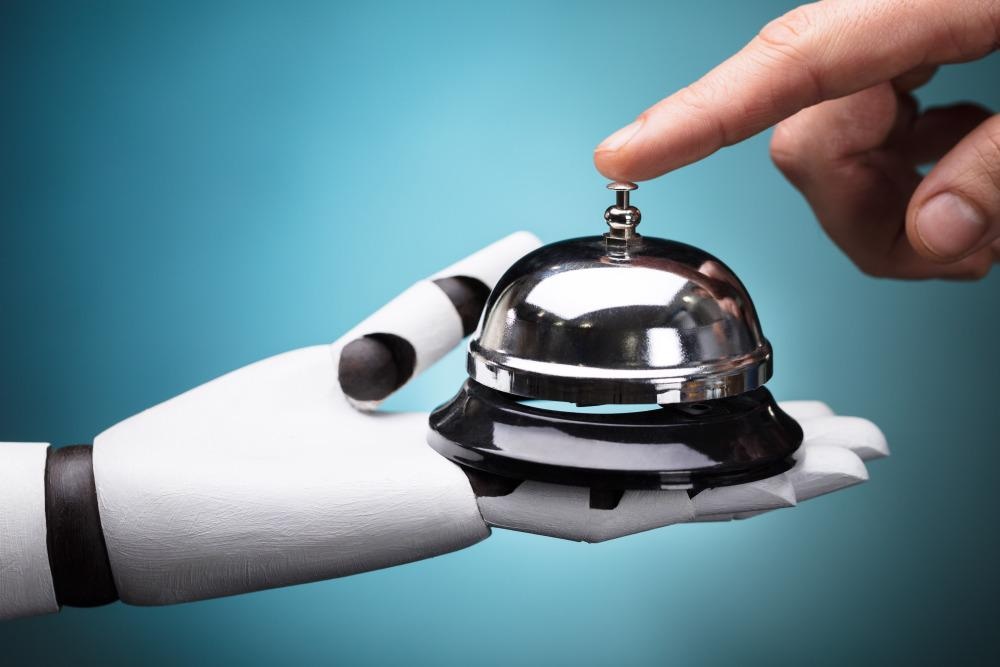The hospitality industry – suffering from the human and economic shock of COVID-19 – must adopt new ways of interacting to prevent infection and keep staff and customers safe. Service robots may hold the key to the socially distanced hospitality of the future, but some challenges remain.

Image Credit: Andrey_Popov/Shutterstock.com
The COVID-19 outbreak and subsequent measures put in place to prevent the disease from spreading have led to more hospitality businesses employing service robots. These businesses expect customers to prefer robot-staffed establishments because they will appear safer.
A heightened public awareness of infection risks may be the driving force behind the widespread adoption of service robots in the hospitality industry. The cost and capabilities of robot technology have made it suitable for hospitality applications for some time, although public perception has limited its use.
Levels of Intelligence
Service robots can be classified into four groups according to the level of artificial intelligence they use: mechanical, analytical, intuitive, and empathetic.
Mechanical intelligence helps robots complete standardized and transactional tasks that do not require very much learning. Analytical intelligence means that robots can use systematic and rule-based learning from big data to enable logical thinking and decision-making. With these two levels of intelligence, service robots can tackle functional tasks like food delivery and answering customer questions.
Intuitive intelligence enables robots to process holistic and contextual thinking. Robots with intuitive intelligence can provide personalized services to customers. Empathetic intelligence requires robots to recognize and respond appropriately to human emotions, which is necessary for socially and emotionally interactive services.
Service robot development is focused on achieving these higher levels of intelligence to enable robots to work in frontline customer-facing positions. However, many in the hospitality industry still prefer including humans alongside robots to carry out the social and emotional tasks of empathetic interaction.
Human-Like Service Robots?
A service robot’s level of intelligence and robotic technology are not the only factors involved in whether or not companies and customers will accept it. Many robotics scientists have argued for the inclusion of anthropomorphic design to make it easier for people to accept robots’ help, and this is also taken up in hospitality.
Scholars have found that human-like robots in hospitality settings lead to more positive emotions and stronger trust from customers. Customers are likely to expect better service from human-like robots, and diners expect food to be better when their robot chefs are anthropomorphized.
Surprisingly, customers also expect service robots to act like humans when they look like humans, expecting them to partake in service recovery efforts such as fixing problems for customers just as human workers would do.
Uncanny Valley
While this evidence may point to increased customer acceptance of more human-like service robots, the psychological phenomenon known as the “uncanny valley” continues to affect interactions with robots. When robots are too human-like, they seem uncanny, eerie, and strange. This makes people uncomfortable, and less likely to interact with them.
Interpersonal skills are a key driver of service encounter satisfaction in the hospitality industry. The tautology that human-like service robots tend to have worse interpersonal skills than real humans bears repeating.
Some researchers have found that human likeness in service robots creates no or even a negative effect on customers’ perceptions.
Different Consumer Attitudes Toward Service Robots
The different responses to humanoid service robots displayed by consumers indicate that various external factors come into play and shape the responses differently. Individual factors like the consumer’s openness toward new technology and situational factors like how crowded the space all have a bearing on the service robot’s acceptance.
Customers who are innovative, open to new technologies, or do not desire human interactions in service encounters are more likely to accept service robots. Similarly, those in favor of social distancing are also more likely to accept service robots.
Where hotel is staffed by robots - BBC Click
Video Credit: BBC Click/YouTube.com
More Motivation for Accepting Service Robots
The acceptance challenges faced by service robots in the hospitality industry may be overcome due to COVID-19.
Globally, people are aware and careful of the risks of spreading infection. Individuals, organizations, and governments worldwide have been working to minimize infection risks as much as possible over the last two years, and introducing robots to hospitality is a good way of removing actual and perceived risks.
Robots for room service and cleaning in hotels, delivering food and parcels, driving cars, and flying drones can all reduce the amount of contact between customers and workers.
The future of hospitality could well be socially distanced. Already, chatbots are used frequently to automate remote customer service tasks. The Henn-na Hotel in Nagasaki, Japan is the first hotel in the world to be entirely staffed by robots. Global hotel chain, Hilton, has developed a robot concierge with IBM, “Connie.”
Continue reading: An Introduction to the Robots Working at Your Local Airport.
References and Further Reading
Choi, S. and L.C. Wan (2021)The Rise of Service Robots in the Hospitality Industry: Some Actionable Insights. [online] Boston University. Available at: https://www.bu.edu/bhr/2021/10/04/the-rise-of-service-robots-in-the-hospitality-industry-some-actionable-insights/
Rosete, A. et al. (2020) Service Robots in the Hospitality Industry: An Exploratory Literature Review. International Conference on Exploring Services Science. Available at: https://doi.org/10.1007/978-3-030-38724-2_13
Seyitoğlu, F. and S. Ivanov (2020) Service robots as a tool for physical distancing in tourism. Current Issues in Tourism. Available at: https://doi.org/10.1080/13683500.2020.1774518
Disclaimer: The views expressed here are those of the author expressed in their private capacity and do not necessarily represent the views of AZoM.com Limited T/A AZoNetwork the owner and operator of this website. This disclaimer forms part of the Terms and conditions of use of this website.